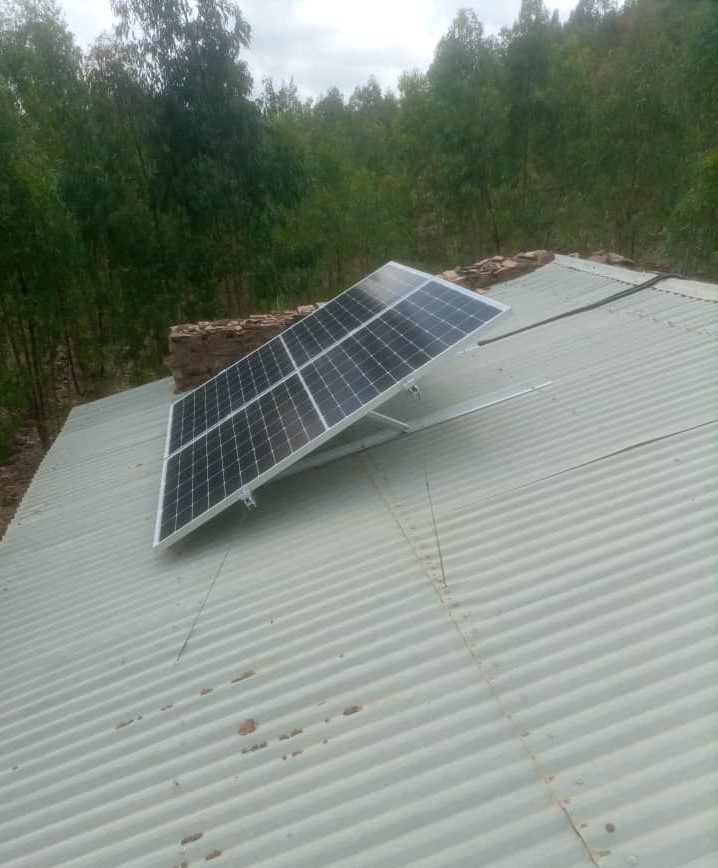Solar-Powered Charging Stations for Internally Displaced Persons (IDPs) in Tigray
Tuesday, October, 8th, 2024 News

By: Seyfe Tareke Woldehiowt, Aregawi Kidanemariam Gebru, and Goitom Yisfa Alemu
Mekelle University (Ethiopia)
Introduction
The ongoing humanitarian crisis in Tigray, Ethiopia, has had a devastating impact on internally displaced persons (IDPs), limiting their access to essential services, particularly electricity. This lack of power has hindered communication, education, and economic opportunities, exacerbating the challenges faced by IDPs. To address this pressing issue, a solar-powered charging station was established at the 70 Karie IDP center in the Mekelle Zone. Funded by the Talloires Network of Engaged Universities and the OSUN Civic Engagement Initiative, the project aimed to provide sustainable and reliable access to electricity, empowering IDPs and improving their overall well-being.
Empowerment Through Connectivity
The solar-powered charging station at the 70 Karie IDP center is a crucial lifeline, providing electricity to 296 households, including 107 female-headed households, and benefiting over 1,500 individuals. By ensuring reliable electricity for mobile devices, the project has empowered IDPs to:
- Stay Connected: Maintain contact with family and friends, access essential information, and utilize mobile banking services. For instance, IDPs were able to send and receive money transfers to support loved ones in other regions or to purchase essential goods.
- Enhance Access to Information: Stay informed about current events, access educational resources, and seek medical advice. IDPs were able to use their mobile phones to research health symptoms, locate nearby clinics, and connect with healthcare providers.
- Economic Empowerment: Engage in income-generating activities, such as selling goods online or offering services through mobile platforms. The charging station provided the necessary power for IDPs to conduct business transactions and communicate with clients.
- Community Building: Serve as a communal space, fostering social interaction and unity among IDPs. The charging station became a hub for community gatherings, allowing IDPs to connect, share experiences, and build support networks.
Methodology
To ensure the project’s effectiveness and sustainability, a comprehensive methodology was employed:
- Needs Assessment: A detailed needs assessment was conducted through surveys, focus group discussions, and key informant interviews to identify the specific electricity requirements and preferences of the IDP community.
- Feasibility Study: A comprehensive feasibility study evaluated the technical, economic, and social viability of implementing solar-powered charging stations in the target population. Factors such as solar radiation, load demand, and community acceptance were carefully considered.
- Community Engagement and Design: IDP community members were actively involved in the design and planning of the charging station, ensuring that the project aligned with their specific needs and priorities. This participatory approach fostered a sense of ownership and commitment among the community.
- Site Selection and Installation: The charging station was strategically located within the camp, considering accessibility, security, and solar exposure. The installation adhered to technical standards and safety protocols to ensure the system’s reliability and durability.
- Capacity Building: Local technicians and community members received training on the operation, maintenance, and troubleshooting of the solar-powered system. This capacity building ensured that the community was equipped to manage and maintain the charging station in the long term.
- Impact Assessment: A mixed-methods approach was used to evaluate the project’s impact, including quantitative data on electricity usage and charging frequency, as well as qualitative data from interviews and focus groups. This comprehensive assessment provided insights into the project’s effectiveness and its impact on IDPs’ lives.
Community Engagement and Sustainability
A participatory approach was adopted to align the project’s goals with the specific needs of the IDP community. This fostered a sense of ownership among community members and ensured their commitment to the project’s long-term sustainability. By involving IDPs in all stages of the project, from planning to implementation, the project team was able to build trust and create a strong sense of community ownership.
Impact and Future Directions
The project’s impact was assessed through surveys, interviews, and observations. Key findings include:
- Increased Communication and Connectivity: IDPs reported noticeable improvements in communicating with family, friends, and essential services. Many IDPs were able to stay in touch with loved ones who had been displaced or separated, providing much-needed emotional support and reassurance.
- Enhanced Access to Information: Access to electricity enabled IDPs to stay informed about current events, access educational resources, and seek medical advice. This improved access to information empowered IDPs to make informed decisions about their lives and well-being.
- Economic Empowerment: Some IDPs utilized the charging station to engage in income-generating activities, such as selling goods online or offering services through mobile platforms. The charging station provided the necessary power for IDPs to conduct business transactions and expand their economic opportunities.
- Community Building: The charging station promoted social interaction and a sense of community among IDPs. By providing a common space for gathering and socializing, the charging station helped to strengthen community bonds and resilience.
Future plans include expanding the initiative to more IDP camps in the Tigray region and collaborating with local businesses and organizations to ensure the project’s long-term sustainability and effectiveness. By replicating this successful model in other areas, the project can reach a larger number of IDPs and make a significant contribution to their recovery and well-being.
Conclusion
The solar-powered charging station project in Tigray demonstrates the transformative potential of renewable energy solutions in addressing the urgent needs of displaced populations. By providing access to electricity, the project has empowered IDPs, improved their livelihoods, and contributed to the resilience of the entire community. The project’s success underscores the importance of community-centered approaches and the potential for sustainable solutions to humanitarian crises. Future efforts should focus on expanding the program’s reach and exploring innovative approaches to ensure its long-term sustainability.